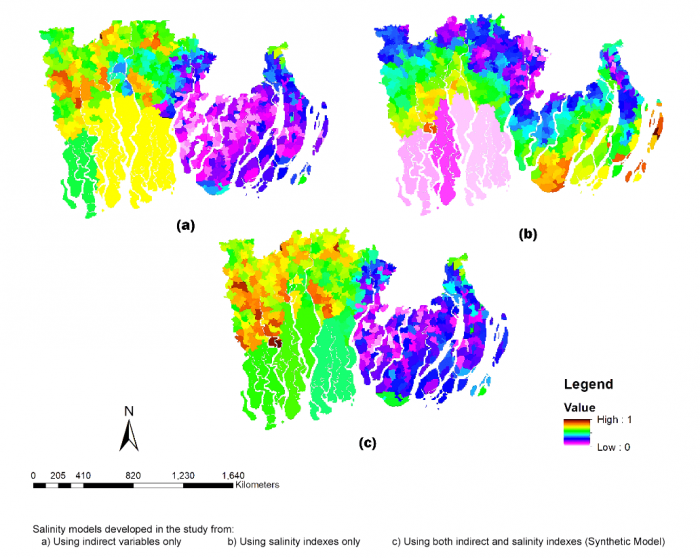
Climate change and associated sea-level rise is an imminent and inevitable threat for low-lying countries like Bangladesh. Additionally, a new concern of increased salinity is making its mark due to the coastal area being inundated by the sea. Increased salinity and salinity intrusion are not simply environmental issues, but have far-reaching public health and policy implications as well.
The country’s coastal area is already home to around 40 million people. The majority of this population is directly dependent on natural resources for their livelihoods and sustenance. An increased salinity, therefore, would mean that the area experiences an acute shortage of freshwater from the rivers, decreased fertility of the soil due to salt accumulation, and, more importantly, mass migration away from the coast due to loss of livelihoods.
For people deciding to stay, cope, and adjust with this situation, the increased salinity levels may have deadly health consequences. It is already scientifically established that high salinity levels in drinking water are associated with renal failures, high blood pressure, heart attacks, strokes, and osteoporosis (bone weakening). Recently, it has also been linked with higher risk of miscarriages and increased abortion rates. Therefore, the salinity condition in coastal Bangladesh requires a careful and frequent monitoring, especially for devising in-situ adaptive and development strategies.
The efficacies of these adaptation programs will, in turn, depend directly on the rapid identification of salinity affected areas and detection of the changing nature of surrounding geo-physiology.
It is also important to consider that despite salinity intrusion being a dynamic process which requires periodic observations, the conventional field-based method of measuring soil-salinity is both time-consuming and expensive. This is mainly because the process involves a dense sampling in a huge geographic area that is followed by an extensive laboratory-based analysis. Furthermore, a conventional soil sample survey is too resource-intensive to be conducted frequently in a resource-scarce county like Bangladesh. Consequently, soil salinity measurements take place in intervals of several years, and the salinity status during the interim period is unavailable for the affected areas, precluding continuous monitoring of salinity status.
With the advent of geospatial technologies like Remote Sensing and Geographic Information System (GIS), it is possible to obtain an estimation of salinity levels from readily available satellite images. It is now possible to capture satellite images that allow computation of different environmental variables, such as the vegetation content, surface water flow, and the salinity status of an area. Although such images are regularly used in arid and semi-arid regions to estimate soil salinity, its use for measuring salinity levels in coastal areas of Bangladesh is complicated due to the extremely diverse geographic setting of the coast.
The heterogeneous coastal region is characterized by mangrove swamps, tidal flats and creeks, natural levees, estuaries, muddy flats, and sandy beaches. As a result, vegetation cover hinders the incoming solar radiation from reaching the crustal salt and also precludes its reflection back to the satellite. As satellite images are produced based on the type and amount of radiation that each satellite receives, important information regarding salinity are lost due to spectral obscurity.
In addition to this problem, hydrological activities contribute to spectral inconsistencies in these satellite images. For example, due to tide and flood, the salts are constantly being deposited and washed away. This heavily complicates salinity estimations from satellite data as salinity levels tend to fluctuate both seasonally and annually.
A team of scientists has set out to find the best solution to this problem. Their main objective was to find out the best technique of measuring soil salinity in a vegetation-covered and hydrologically active geophysical setting, which is common to countries having a significant portion of land near the coast, like Bangladesh. With this aim, they developed three soil salinity models with indirect (Figure 1a), direct (Figure 1b), and a combination of both of these soil salinity measurement techniques (Figure 1c) for south-western Bangladesh.

Image republished with permission from Elsevier from https://doi.org/10.1016/j.envdev.2018.12.007
The direct measurement involved employing five conventional salinity indexes that are commonly used for estimating salinity levels in the arid and semi-arid regions (such as the countries in the Middle East). The term “direct” signifies that these indexes can be directly calculated from satellite images and also gives a direct estimation of the salt content of a region. In contrast, the indirect measurement comprised of eleven environmental variables, which are generally used as proxy measures of salinity. These variables are either directly influenced by soil salinity or contribute to an increased salinity. Therefore, estimating their levels can shed an important insight to the degree of salinity in the study area.
For example, it is generally established that increased salinity adversely affects the vegetation content of a region. Therefore, the environmental variable that corresponds to vegetation status in an area can be a good indication of the salinity condition. An increase of the variable would conform to decreased salinity level and vice versa.
In the third model, which is termed as the “synthetic model,” they combined the two previous models using an advanced statistical technique called the Principal Component Analysis. Although it may sound quite simple to combine two models, in reality, due to the high variability in nature of the computed variables, the merging process is extremely complex. Necessary precaution had to be taken to ensure that the models do not conflict internally during the merging process. The predictability of the three models was then evaluated against ground-based soil salinity measurements from the government’s soil survey.
In terms of both accuracy and predictability, the synthetic model outperforms the models developed from direct and indirect measurement techniques. This is because the synthetic model can capture more variables and include the inter-variable interactions, compared to the two singular models. The high predictability of the synthetic model indicates that it can be used as a very good alternative to the extensive and expensive field-based salinity surveys.
Additionally, if the constructed synthetic salinity model can be integrated with periodic random sampling for actual soil salinity measurements on the ground, the model can be continuously validated and upgraded for an increased accuracy. Periodic random sampling is more cost-effective and less time consuming, especially when compared to extensive field-based soil salinity measurements of the vast coastal area.
As satellite data is inexpensive and can be acquired at frequent intervals, their developed process would allow constant monitoring of salinity affected areas. For a resource-constrained country like Bangladesh, this knowledge, in turn, could be used to rapidly strategize policies to decelerate salinization, formulate early warning systems, and prevent loss of livelihoods of the millions of people living in the coastal areas of Bangladesh.
These findings are described in the article entitled Modeling soil salinity using direct and indirect measurement techniques: A comparative analysis, recently published in the journal Environmental Development.









